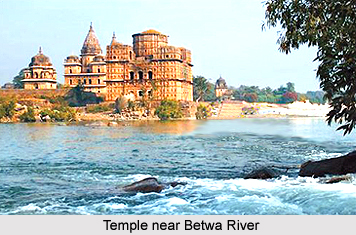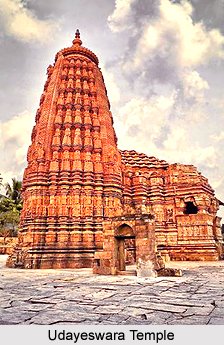 History of Vidisha district speaks about the architectural development of the district in the past. Vidisha or Besnagar as it is known in the Pali scriptures, once the prosperous capital of the western dominions of the Sungas, possesses some of the remarkable antiquities which throw light on the appreciable architectural development of the period
History of Vidisha district speaks about the architectural development of the district in the past. Vidisha or Besnagar as it is known in the Pali scriptures, once the prosperous capital of the western dominions of the Sungas, possesses some of the remarkable antiquities which throw light on the appreciable architectural development of the period
.Located in the fork of the Betwa river and Bes rivers, Vidisha district, ten kilometers from Sanchi Stupa occupies a prominent place amongst the ancient Indian districts. In the sixth and fifty centuries BC, it rose to become a major trade centre and a bustling city under the Sunga Dynasty, Satvahanas, Nagas and Guptas. Emperor Ashoka was the governor of Vidisha, and it finds mention in Kalidasa`s immortal Meghdootam. Deserted for three centuries after the sixth century, it was renamed Bhilsa by the Muslims who constructed the now ruined Bija Mandal, a mosque erected from the remains of Hindu temples. Later, it passed on to the Sultans of Malwa, the Scindias and the Mughal dynasty. The Vidisha territory was ruled by the Mauryan Empire, the Sungas, the Nagas, the Vakatakas, the Kanvas, the Guptas, the Parmars, the Kalchuris of Mahishmati, the Chalukya Dynasty, the Mughals, the British, etc.
 The Vidisha district derives its name from the headquarters town of Vidisha. The earliest reference of Vidisha is also there in the great epic of Ramayana by Valmiki. In the epic, it is stated that, the son of Shatrughna called Shatrughati was placed in charge of Vidisha. In Brahmanical religious observance, the place is called Bhadravati, the residence of Yuvanashva who supplied the famous horse to Yudhisthir during his Ashvamedha sacrifice. The historicity of the ancient city of Besnagar, three kilometers from Vidisha and identified with ancient Vidisha, goes back to some centuries before the birth of Jesus Christ. Besnagar figures significantly in Buddhist, Jain and Brahmanical literature in various forms like Vaisyanagar, Vessanagar, etc. Tradition connects the town with Raja Rukmangada who neglecting his own wife for the Apsara Visva named the town Vishvanagar after her. On the destruction of Besnagar, situated on the western side of the Betwa River sometimes after the seventh century A.D., a new town sprang up on the Eastern bank of the River. This new town was known as Bhailaswamin or Bhillaswamin, the name of the place was later corrupted to `Bhilsa` or `Bhelsa`. The name Bhelsa appears to have probably been received on account of the famous Suryamandir dedicated to the Sun god.
The Vidisha district derives its name from the headquarters town of Vidisha. The earliest reference of Vidisha is also there in the great epic of Ramayana by Valmiki. In the epic, it is stated that, the son of Shatrughna called Shatrughati was placed in charge of Vidisha. In Brahmanical religious observance, the place is called Bhadravati, the residence of Yuvanashva who supplied the famous horse to Yudhisthir during his Ashvamedha sacrifice. The historicity of the ancient city of Besnagar, three kilometers from Vidisha and identified with ancient Vidisha, goes back to some centuries before the birth of Jesus Christ. Besnagar figures significantly in Buddhist, Jain and Brahmanical literature in various forms like Vaisyanagar, Vessanagar, etc. Tradition connects the town with Raja Rukmangada who neglecting his own wife for the Apsara Visva named the town Vishvanagar after her. On the destruction of Besnagar, situated on the western side of the Betwa River sometimes after the seventh century A.D., a new town sprang up on the Eastern bank of the River. This new town was known as Bhailaswamin or Bhillaswamin, the name of the place was later corrupted to `Bhilsa` or `Bhelsa`. The name Bhelsa appears to have probably been received on account of the famous Suryamandir dedicated to the Sun god.
Samrat Ashoka, a prince aged eighteen years, was appointed as a Viceroy by his father, Bindusara, at Ujjain. While on his way from Pataliputra to that place he met Devi, a banker`s daughter of Vidisha or Besnagar of the Sakya clan and married her. Her son Mahendra and daughter Sanghmitra are famous in history as their father`s religious ambassadors to Ceylon. They are known to have carried a twig of the original `Bodhi tree` and led a Buddhist Mission to that country. Devi never visited Pataliputra and stayed at Besnagar only and embraced Buddhism afterwards. A monastery type of building has been excavated near Sanchi setup, about eight kilometers from Vidisha, which is stated to have been constructed for her residence. It is said that before sailing for Ceylon Mahendra came to visit his mother at Besnagar and the mother took her son to a `Chaitya Giri` which, by popular belief was none other than the Sanchi Stupa.
After the Mauryas the Sungas, the Kanvas, the Nagas, the Vakatakas, the Guptas, the Kalchuris of Mahishmati, the Parmars, and the Chalukyas remained in power at Vidisha. Idols regarding these regimes have been found in the Vidisha territory. Some idols and monuments are placed in the District Archaeology office at Vidisha. Later, this region remained under Mughals, Marathas and Peshwas and thereafter became a part of the Schendia`s Gwalior State and was a tehsil of Isagarh Pargana. In the year 1904, it was raised to a district having two tehsils of Vidisha and Basoda till the formation of Madhya Bharat in the year 1948. The District was enlarged in the year 1949 by the merger of small states of Kurwai. The Sironj sub-division, which was formerly in the Kota district of Rajasthan state and small pargana of Piklone belonging to Bhopal were added to the district with the formation of new state of Madhya Pradesh. At the same time, the town and the district were renamed as Vidisha. However, under the Mughals, Aurangzeb tried to rename it as Alamgiri Nagar after himself, but without success. Even today, the antiquity and the modern historical progress of the plateau of Vidisha vividly reflect its grandeur in the form of Besnagar, Gyaraspur, Udaypur, Udaygiri, Badoh-Pathari etc.



















